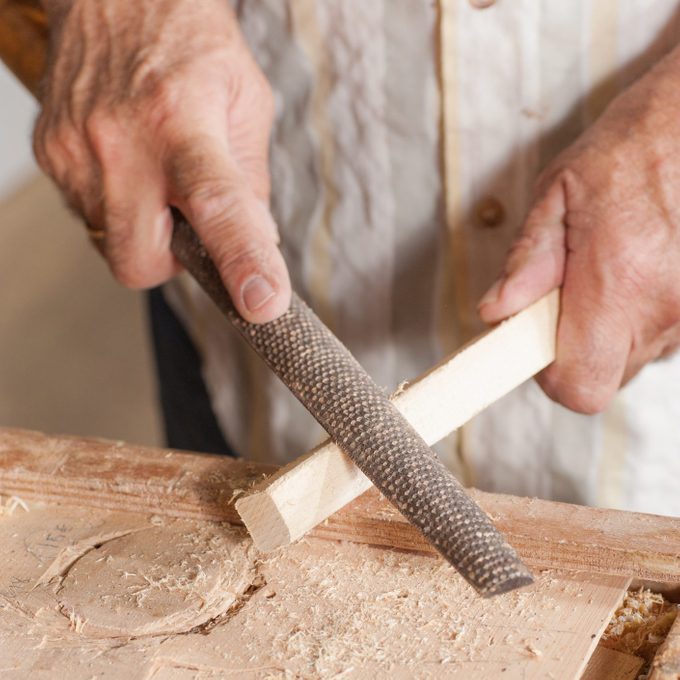

Rasps and files may not be the first shop items beginning DIYers think to acquire. But much like clamps, rasps and files seem to magically proliferate, and most accomplished woodworkers accumulate a wide array.
In this article we’ll explore these unsung heroes of the woodworking world, explaining why rasps are so well-loved by woodworkers and what you’ll need to start your own collection.
On This Page
What Is a File?
A file is a hand tool with rows of metal teeth across its face. The size and pattern of the teeth determine how much wood will be taken off with each pass.
The teeth on single-cut files run in one direction, while double-cut files have a crisscrossing pattern to remove wood more aggressively. A file’s face is solid, with small valleys (“gullets”) between rows of teeth for waste material to collect.
What Is a Rasp?
Rasps are similar to files in size and shape. They’re used to make coarse cuts on a wood surface, removing material quickly.
Here’s the difference: Instead of a file’s neat rows of teeth, rasps feature raised individual teeth. On some rasps, the teeth are widely spaced. Other rasps look like a cheese grater, with a hole at the base of each tooth, allowing large amounts of material to shed away. Called “surforms,” they may be shaped like a traditional handheld rasp, or incorporated into a block plane-like body.
When To Use Rasps and Files

In general, rasps are used before files, just like you sand with a coarse grit before turning to a finer grit. Rasps remove material quickly, leaving a rough surface that requires smoothing and refinement by a file or sandpaper.
Rasps and files each have various shapes and tooth styles to deal with all the curves, shapes and angles encountered in woodworking. When manufacturers describe files and rasps, they usually refer to the tool’s size, shape and tooth profile or “cut.” The latter may describe more than one element of a file’s or rasp’s design.
Size usually refers to the length of the tool. Tooth profile is usually described in a simple grade. Listed from smoothest to coarsest, these include smooth, second-cut, bastard and coarse.
Here are some common types of woodworking rasps and files:
Flat rasps and files
Flat rasps level out uneven surfaces, like a hand plane. Flat files smooth out level surfaces. On each, one side generally has teeth (cut) while the other doesn’t (uncut). An uncut side can touch the work surface without removing any wood, helpful when working in a corner.
Round rasps and files
Round rasps and files feature a circular profile. They’re ideal for working inside corners and creating or smoothing holes. They’re often tapered to fit various hole/curve sizes. Thin round rasps and files may be called needles or rat tails.
Half-round rasps and files
These have a half-circle profile. A half-round’s flat back gives added stability and control, often with a different coarseness than the curved front. Much like a flat file or rasp, the sides of a half-round may be cut or uncut.
Detail rasps and files
Detail tools tend to have narrower faces to fit into tighter spots. They may also be curved, with an angled handle or tang, to make it easier to access hard-to-reach areas.
Best Rasps and Files
Between size, shape and tooth profile, there are enough file and rasp variations to fill an entire workshop. If you’re starting out, we suggest getting a few basic sizes and shapes, then filling in with specialty files or rasps as needed.
Here are some great choices for beginners:
Libraton Three-Piece Rasp Set: This comes with a flat and two sizes of half-round wood rasps. We like that the back side of each is a finer-toothed metal rasp for shaping metal objects. As a bonus, the set comes with a 28-piece selection of sandpaper.
Andgoo Two-Piece Combo Rasp and File: Save yourself a trip to the toolbox with these combo files and rasps. When you’re done with the rasp end, simply flip it over and finish the job with the file pattern. It comes with one flat and one half-round tool, each with a rasp on one end and a double-cut file.
Kalim Six-Inch Double-Cut Flat File: This classic profile is a good all-around flat file to have on hand. It ships without a handle, so you’ll have to provide your own. With tang, the file’s full length is 7-1/2-inches.
Kobalt Three-Piece File Set: A nice introductory set, this includes three eight-inch files, all with their own handles. The flat mill file features a smooth single-cut pattern on one side and second-cut tooth pattern on the other. The half-round has a second-cut pattern and the round file a bastard pattern for faster removal of material.
Did you miss our previous article…
https://tophouseimprovement.com/how-to/these-simple-hacks-can-fix-stuck-wooden-drawer-slides/
